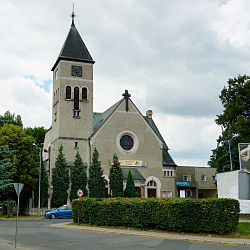St. John's Church (Zgorzelec)
| St. John's Church Polish: Kościół św. Jana Chrzciciela |
|
|---|---|
|
Kościół św. Jana Chrzciciela |
|
| Construction time: | 1905-1907 |
| Inauguration: | May 15, 1907 |
| Builder : | Fehler (father of Alfred Fehler ) |
| Architect : | Arno Eugen Fritsche |
| Style elements : | Neo-Romanesque |
| Location: | 51 ° 8 '17 " N , 15 ° 0' 44.4" E |
| Address: | ulica Grunwaldzka 2 Zgorzelec Lower Silesia , Poland |
| Purpose: | roman catholic church |
| Parish: | św. Jana Chrzciciela |
| Diocese : | Legnica |
| Website: | www.janchrzcicielzg.parafia.info.pl |
The Johanneskirche or parish church of St. Johannes (Polish: Kościół św. Jana Chrzciciela ) is a Roman Catholic church in the Zgorzelec district of Ujazd in the Polish Upper Lusatia . It was built after 1900 as a Protestant church in the still independent village of Moys. In 1929 Moys was incorporated into Görlitz . After the Second World War, the areas east of the Oder and Lusatian Neisse, and thus also the eastern districts of Görlitz, fell to Poland in accordance with the Potsdam Agreement . The church has been used as a Catholic parish church by a Polish community since the end of the war . She is a member of the Zgorzelec deanery. The church is dedicated to John the Baptist .
history
The village of Moys was first mentioned in the 14th century. Moys was parish in the Protestant parish of Görlitz. The believers visited the Holy Trinity Church on Obermarkt or St. Peter's Church for the services . There was a Moyser gallery in both churches. Since 1894, in the winter months from December to March, an evening service was held by clergymen from St. Peter's Church in the old schoolhouse in Moys in order to avoid walking into Görlitz's old town . Later, the services were held in the guest room of the Brno City Inn . As the population grew, so did the Moys citizens' desire to build their own church.
On May 11, 1899, a local church building association was established . In the same year the widow Davida von Berge donated 10,000 marks to the parish council for the building of the church. However, it stipulated that the construction should be completed within five years. The entrepreneur Julius Arnade, owner of the Moyser case factory, donated the building plot on Seidenberger Straße (today: ulica Łużycka) to the community.
The foundation stone was finally laid on November 24, 1905 . The decision was made in favor of the neo-Romanesque design by the architect Arno Eugen Fritsche , who also designed the Görlitz Luther Church . The construction was carried out by master bricklayer Fehler, father of the future mayor Alfred Fehler .
Already on May 15, 1907 the church was consecrated by the Liegnitz general superintendent Wilhelm Haupt and superintendent Kirchhofer. The Görlitz architect Gustav Röhr designed the festival decorations from Seidenberger Straße to the church. Röhr was also responsible for the design of the font . The church construction cost 80,940.15 marks, of which the church building association had collected 8,426.15 marks. Numerous items of equipment were also donated. The consecration of bells took place on September 26, 1906 . The three bronze bells with the disposition es-gb were manufactured in 1906 by the renowned Schilling foundry and weighed 2.15 tons.
Two of the three bells were confiscated during the First World War and melted down for the armaments industry. In 1919 three new cast steel bells were wound. They were donated by Elisabeth Haebler. The company Schilling & Lattermann was commissioned with the casting. The bells weighed 250, 450 and 900 kilograms, respectively. The three bells still hang in the church tower today. The inscriptions on the bells read: "Be Merry in Hope", "Be patient in tribulation" and "Stop in prayer".
The church remained parish in Görlitz and was part of the Peterskirche parish. After the end of World War II , the new Polish residents of Moys took over the church. The church was handed over in 1958 by the Protestant Church to the Roman Catholic St. Boniface Congregation. In the following years renovation work was carried out on the church building. Since 1961 masses have been held regularly in the church. In April 1972 the church was spun off from the parish of St. Boniface and has since formed an independent parish . In the period after 1945 a two-storey house with a flat roof was added to the western nave.
Individual evidence
- ↑ Wolf-Dieter Fiedler: A walk through the old Görlitz-Moys . Senfkorn-Verlag, Görlitz 2012, p. 72 f .
- ↑ a b Wolf-Dieter Fiedler: A walk through the old Görlitz-Moys . Senfkorn-Verlag, Görlitz 2012, p. 73 .
- ↑ Wolf-Dieter Fiedler: A walk through the old Görlitz-Moys . Senfkorn-Verlag, Görlitz 2012, p. 73 f .
- ↑ a b Wolf-Dieter Fiedler: A walk through the old Görlitz-Moys . Senfkorn-Verlag, Görlitz 2012, p. 7 .
- ↑ janchrzcicielzg.parafia.info.pl: Historia Kościoła (Polish). Retrieved June 1, 2012 .
- ↑ Wolf-Dieter Fiedler: A walk through the old Görlitz-Moys . Senfkorn-Verlag, Görlitz 2012, p. 75 .

